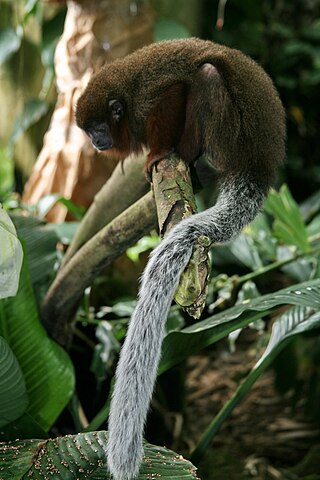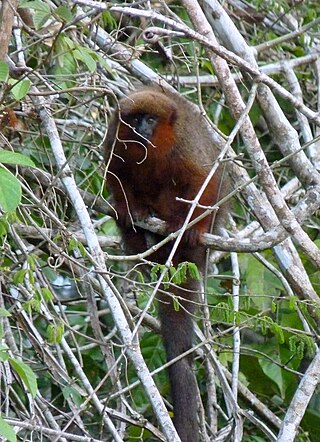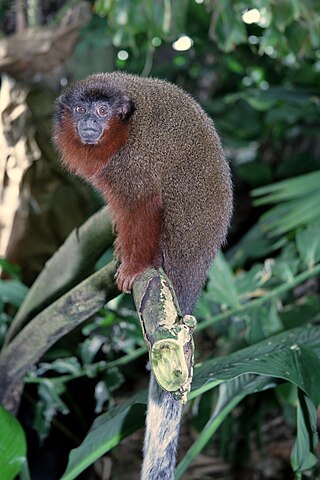
The Pitheciidae are one of the five families of New World monkeys now recognised. Formerly, they were included in the family Atelidae. The family includes the titis, saki monkeys and uakaris. Most species are native to the Amazon region of Brazil, with some being found from Colombia in the north to Bolivia in the south.

The titis, or titi monkeys, are New World monkeys of the subfamily Callicebinae, which contains three extant genera: Cheracebus, Callicebus, and Plecturocebus. This subfamily also contains the extinct genera Miocallicebus, Homunculus, and Carlocebus.

Callicebus is a genus of monkeys known as titi monkeys.

The Madidi titi monkey, also known as the GoldenPalace.com monkey or the golden palace monkey, is a titi, a kind of New World monkey, discovered in western Bolivia's Madidi National Park in 2004. Its scientific name is Plecturocebus aureipalatii, the specific epithet meaning "of the Golden Palace", in reference to GoldenPalace.com, an online casino which paid US$650,000 to have the species named after it, with benefits going toward the nonprofit organization that maintains the park where the titi was discovered.

The collared titi monkey is a species of titi, a type of New World monkey. It is endemic to northern Brazil.

Stephen Nash's titi monkey, also known as just Nash's titi or Stephen Nash's monkey, is a species of titi monkey, a type of New World monkey, endemic to the eastern bank of the Purus River in Brazil. It was discovered by Marc van Roosmalen in 2001 when local fishermen brought specimens to his breeding center. It was described in 2002. It was named in honor of Stephen D. Nash, an illustrator for Conservation International, the organization that funded van Roosmalen's work. The monkey is largely silver with a black forehead and red sideburns and chest, as well as on the underside of the species' limbs. It is 28 inches long, although 17 inches is taken up by the titi's tail.

The white-coated titi monkey is a species of titi monkey, a type of New World monkey, from South America. It is found in Bolivia, Brazil, and Paraguay.

The red-bellied titi monkey or dusky titi is a species of titi monkey, a type of New World monkey, endemic to Brazil. It lives in forests and thickets.

The white-eared titi monkey also known as the Bolivian titi or Bolivian gray titi, is a species of titi monkey, a type of New World monkey, from eastern Bolivia and an area of western Brazil. The species has a range that extends east from the Manique River in Beni Department, Bolivia to southern Rondônia in Brazil. The southern end of its range includes forests around the city of Santa Cruz de la Sierra.

The brown titi monkey is a species of titi monkey, a type of New World monkey, from South America. It is endemic to Brazil. It was originally described as Callicebus brunneus in 1842 and transferred to the newly erected genus Plecturocebus in 2016.

Prince Bernhard's titi monkey, also called the zog-zog monkey, is a species of titi monkey in the genus Plecturocebus, first described in 2002. It is named after Prince Bernhard of the Netherlands. They have varying coloration of gray, black, and agouti, with dark orange in certain regions. They are endemic to Brazil, found mostly in disturbed forest environments. While officially listed as least-concern by the International Union for the Conservation of Nature (IUCN), they may, in fact, be at-risk due to human-caused deforestation.

Vieira's titi monkey is a species of titi, a type of New World monkey, from central-northern Brazil.
Milton's titi monkey is a species of titi monkey, a type of New World monkey, from southern Amazon rainforest, Brazil. It was named after the Brazilian primatologist Milton Thiago de Mello. Milton's titi was discovered in 2011 by Julio César Dalponte, and recognized as a new species in 2014.

Plecturocebus is one of three genera of titi monkeys.

The Alta Floresta titi monkey, also known as the Groves' titi monkey, is a species of titi monkey, a type of New World monkey, endemic to Brazil. It was described from the municipality of Alta Floresta in the state of Mato Grosso.
Rylands' bald-faced saki is a disputed species of saki monkey, a type of New World monkey. It is found in Bolivia, Peru, and Brazil.

Toppin's titi monkey is a species of titi monkey, a type of New World monkey, from Brazil, Peru, and Bolivia.

The Urubamba brown titi monkey is a species of titi monkey, a type of New World monkey, endemic to Peru.















